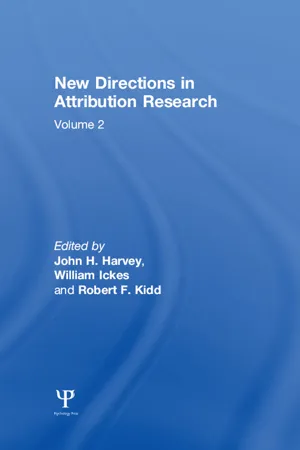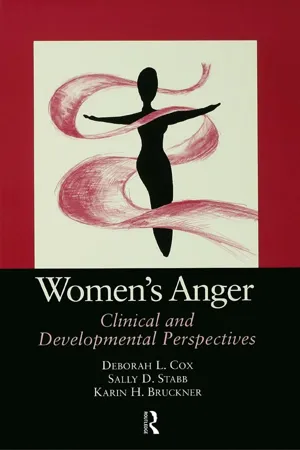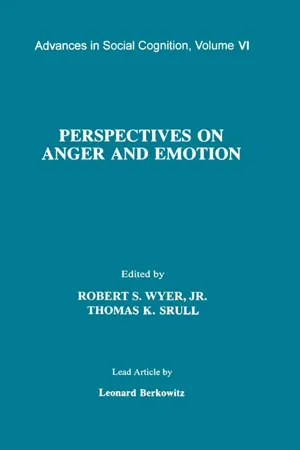Psychology
Schachter-Singer Theory
The Schachter-Singer Theory, also known as the two-factor theory of emotion, proposes that emotions are the result of both physiological arousal and cognitive interpretation of that arousal. According to this theory, the experience and labeling of emotions depend on the individual's interpretation of the physiological arousal in a given situation. This theory emphasizes the role of cognitive processes in shaping emotional experiences.
Written by Perlego with AI-assistance
Related key terms
5 Key excerpts on "Schachter-Singer Theory"
- eBook - ePub
Understanding Psychology for Medicine and Nursing
Insights and Applications
- Mohamed Ahmed Abd El-Hay(Author)
- 2019(Publication Date)
- Routledge(Publisher)
Stanley Schachter and Jerome Singer saw some merit in the previous two theories. According to their theory, emotions were thought to result from the combination of two factors: an initial state of unexplained arousal plus a cognitive explanation (or appraisal) for that arousal. They agreed with James that physiological arousal is a central element in emotion. But they also agreed with Cannon that physiological arousal is very similar for different emotions. Thus, arousal would not produce an emotional response on its own. Instead, Schachter and Singer proposed that cognitive evaluation of what caused the responses is an essential part necessary for its occurrence. The Schachter–Singer theory stressed the interaction of cognitive (intellectual) and physiological (bodily) influences, where physiological arousal was considered as the first component and the interpretation of that arousal as the second one. According to this theory, when people experience arousal, they search for its source. The cognitive explanation, or label, is often quick and straightforward, since a person generally recognizes the event that led to his or her emotional state. When the situation is more ambiguous, the emotion will be determined by the person’s beliefs about the cause of such emotion. This theory thus contradicts James’s assertion that emotion is communicated only on the basis of physical feedback, asserting that this feedback by itself is not clear enough to specify a particular emotion. Rather, the brain chooses one of many possible interpretations and determines the feedback pattern, resulting in the experiencing of a particular emotion (Schachter & Singer, 1962).To prove their proposal that subjects can have different emotional reactions despite being placed into the same physiological state; Schachter-Singer injected male volunteers with epinephrine, to produces sympathetic nervous system arousal. One group was informed that their symptoms were caused by the injection, but the other group was not given this explanation. The subjects who were not informed tended to report feeling either happier or angrier than the informed subjects. Participants were left in a waiting room with another person, allegedly another participant but actually an assistant of the experimenter. The assistant created either a happy situation (by making paper airplanes, playing basketball with wads of paper, and so on) or an angry situation (by complaining about the experiment, tearing up a questionnaire, and so on). The uninformed participants placed in the happy situation rated their feelings as happier than did the informed participants in that same situation. Although the data were less clear for the angry situation, Schachter and Singer claimed that the uninformed participants were angrier than the informed participants. Subjects expressed either anger or happiness, depending on whether another person in the experiment displayed that emotion. Participants who had a physiological explanation for their arousal appeared to be less influenced by the situation than those who did not have an explanation. Hence, the combination of the appraisal of the situation (cognitive) and the participants’ reception of epinephrine or a placebo together determined the response. - eBook - ePub
- J. H. Harvey, W. J. Ickes, R. F. Kidd(Authors)
- 2018(Publication Date)
- Psychology Press(Publisher)
or intense hate. Arousal theory as first formulated by Cannon did not provide the conceptual tools to distinguish sufficiently between the varieties of emotional experience.Schachter (1964) supplemented arousal theory so it would be able to differentiate between emotions. He proposed that emotions are a function of two factors: (1) level of arousal; and (2) cognitions about the arousing situation that provide the “steering” or directionality for emotional experience. The two-factor theory and the study by Schachter and Singer (1962) have proven astonishingly popular and have greatly contributed to the experimental study of emotions. Yet this work appears to have fundamental methodological and theoretical shortcomings (for methodological issues see, for example, Plutchik & Ax, 1967). Here we will consider only the theoretical speculations concerning the arousal—emotion sequence and the place of arousal in a theory of emotions.Arousal Schachter (1964) contends that the perception of an external event or, for example, the ingestion of a particular drug may produce arousal. The social situation then provides the cues to interpret (ascribe the cause for) the arousal and thus label its origin. The labeling, in turn, guides the appropriate emotional experience. But work by investigators such as Lazarus (1966, 1968) strongly suggests that arousal itself is a product of cognitive factors. More specifically, Lazarus reports that how one interprets a stressful situation influences the amount of fear (arousal) that is generated. In a similar manner, in this paper we report data that whether success is followed by activation or calmness depends in part on the perception of the cause of success.It presently is not known whether arousal precedes, accompanies, or follows an emotional experience or if all of the above may be true given disparate situations. The empirical findings reported by Schachter and Singer may indeed be valid, yet there may be other instances in which arousal is not a necessary condition for emotional experience. One implication of the preliminary data presented here is that cognitions are necessary and sufficient causes of emotion. Feeling competent be cause of perceived high ability or feeling gratitude because of an ascription to the help of others does not appear to require a prior state of arousal that the individual must seek to interpret. On the contrary, the degree of arousal seems to be determined by the prior causal cognition. A change in the conception of emotions so that it follows a historical sequence of drive → drive and cognition → cognition only is reminiscent of other historical progressions in the field of motivation, such as the drive → drive and incentive → incentive only - eBook - ePub
Women's Anger
Clinical and Developmental Perspectives
- Deborah Cox, Sally Stabb, Karin Bruckner(Authors)
- 2016(Publication Date)
- Routledge(Publisher)
Although deep considerations of the physiological models of anger fall outside the major foci of this discussion, used as a backdrop these major research trends cast illumination on the automatic, internal anger response. Anger in this light appears more licit, more explainable, easier to accept in its crudest and most unconstrained forms. To consider an automatic visceral process accompanying the phenomenological experience of anger is to acknowledge a side to the emotion that departs from controllability, that speaks to its innateness and its rightful place in human experience.Cognitive Appraisal
The question “How do we become angry?” includes related questions, such as, “What kinds of things make us angry?” “Under what circumstances do we become angry?” “How do our thought processes mediate that emotional upsurge?” and “Why do certain situations anger some but not all of us—and to such varying degrees?” Appraisal is generally construed as our mental “sizing up” of a situation to determine its significance to our immediate stake in things and has been used to answer some of these questions in theory. Historically, the James-Lange theory of emotion (James, 1890 ) and Schacter and Singer’s (1962) two-factor model both distinguish between physiological arousal and cognitive appraisal. They each view emotion, and again by extension anger, as a third type of experience: a product of the interaction between the two. Thus, these very early models set the stage for current thinking regarding the role of appraisal in emotion and the mysterious relationship between thought and feeling.In Dodge’s (1991) model of social information processing, he outlines a basically cognitive framework determined by the processes of encoding, interpretation, response search, response evaluation, and enactment. His theory casts emotion as both goal direction and the experience of feelings. However, unlike Lewis’s (1993) - eBook - ePub
- Paula M. Niedenthal, François Ric(Authors)
- 2017(Publication Date)
- Psychology Press(Publisher)
Whereas evolutionary psychologists study the function of emotion and appraisal theorists study why different people have different emotions in the same circumstances, psychological constructionism tries to explain the huge variation—both within and across individuals—in how emotions look and feel (Barrett, 2006; Cunningham & Brosch, 2012; Kirkland & Cunningham, 2012; Lindquist & Gendron, 2013; Russell, 2003, 2009; Widen, 2013). These theorists ask questions like is there really such a thing as anger, or are there actually many different experiences that we call “anger,” just for convenience’s sake? Psychological constructionists treat variability in emotion language, knowledge, and responding as indications that the things we call “sadness” and “disgust,” for example, are created in the mind of the person experiencing the emotion at that time; emotions are first and foremost psychological realities.An interest in the construction of specific emotions can be traced in part to the Two-Factor Theory of emotion, which we encountered earlier in the chapter, but even more strongly to the writings of William James (1890). James famously noted that most people of his time (scientists and laypeople alike) seemed to believe that having an emotion involved perceiving an emotionally arousing stimulus (he usually referred to a bear in the woods), feeling an emotion, and then taking action (running away from the bear). That is not right, James claimed. Instead, he argued that people perceive the emotionally arousing stimulus, get all jazzed up and take action, and later introspect on their actions and body to fashion an emotion. Constructing the emotional experience involved thinking about their state in their own way and through their own understanding of the situation. In other words, James thought people took a bunch of elemental biological and psychological states and constructed a personal emotional experience for themselves (Lindquist, 2013).Both William James’s ideas and the Two-Factor Theory of emotion were simple ideas that foreshadowed modern constructionist theories. In constructionist theories, primitive feeling states that have a biological basis are shaped into a psychologically reality—into the experiences called “joy” or “disgust”—by the mental processes of perception and interpretation. Modern constructionist theories, in contrast to Schachter and Singer (1962), try to specify how people’s knowledge of emotion categories shapes core affect into specific emotional experiences. - eBook - ePub
Perspectives on Anger and Emotion
Advances in Social Cognition, Volume Vi
- Robert S. Wyer, Jr., Thomas K. Srull(Authors)
- 2014(Publication Date)
- Psychology Press(Publisher)
In claiming that body reactions contribute to the formation of the emotional experience, the present theoretical model is also consistent with one of the classic theories of emotion and suggests that this hallowed formulation should be looked at afresh, although it probably requires some revision. As the reader might have recognized, the general line of reasoning I’ve followed has a family resemblance to the James-Lange theory of emotions. William James and, independently, Carl Lange had argued about 100 years ago that people’s emotional feelings arise from their somatic reactions to the emotion arousing event. James (1890) summarized his argument this way:Common-sense says we lose our fortune, are sorry and weep; we meet a bear, are frightened and run; we are insulted by a rival, are angry and strike. The hypothesis here to be defended says this order of sequence is incorrect … and that the more rational statement is that we feel sorry because we cry, angry because we strike, afraid because we tremble… Without the bodily states following on the perception, the latter would be purely cognitive in form, pale, colorless, destitute of emotional warmth. We might then see the bear, and judge it best to run, receive the insult and deem it right to strike, but we should not actually feel afraid or angry. (pp. 449–450)21James thus proposed that the emotional experience grew out of the aroused persons’ awareness of their bodily reactions. In fundamental agreement with James and Lange but adding to their theory, the cognitive-neoassociationistic model holds that the affected people tend to incorporate their emotion-associated ideas and memories as well as their bodily sensations into this experience, and that the feeling construction is guided by their prototypic conception of the emotional state.22 If some such process contributes to the perception of being angry, it could well also play a part in the formation of other emotional experiences.Effects of Muscular FeedbackAny revision of the James-Lange theory, and for that matter any truly comprehensive analysis of emotions, must recognize (along with the present associative network formulation) that peripheral body reactions can influence the emotional experience. The model offered here, in essential agreement with other conceptions (e.g., Izard, 1990; Tomkins, 1962), accounts for this affect by proposing that associative linkages connect basic emotional feelings with particular muscle movements.
Learn about this page
Index pages curate the most relevant extracts from our library of academic textbooks. They’ve been created using an in-house natural language model (NLM), each adding context and meaning to key research topics.




